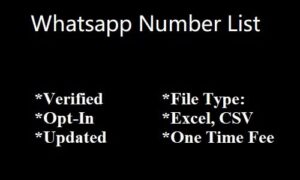WhatsApp, as one of the most popular messaging apps globally, handles vast amounts of data to ensure seamless communication for its billions of users. The app’s data model forms the foundation of its architecture, enabling efficient message delivery and data storage. In this article, we delve into the WhatsApp data model to gain insights into how the app manages and organizes user data.
Message Handling and Delivery:
Heading: Message Handling and Delivery
The core of WhatsApp’s data model revolves around message handling and delivery. When a user sends a message, it is encrypted using end-to-end encryption, ensuring that only the intended recipient can decrypt and read the message. The data model ensures the smooth delivery of messages Oman Whatsapp numbert Data between users, even in scenarios with varying network conditions.
Chat Threads and Conversations:
Heading: Chat Threads and Conversations
WhatsApp organizes messages into chat threads or conversations, where all exchanged messages between two or more users are grouped together. This data model allows users to follow the flow of conversations easily and view past messages within each chat thread.
User Profiles and Contacts:
Heading: User Profiles and Contacts
WhatsApp’s data model includes user profiles, where essential user information is stored, such as names, profile pictures, and status updates. The app also maintains a list of user contacts, making it convenient for users to find and connect with their friends and family.
Media and File Storage:
Heading: Media and File Storage
WhatsApp allows users to share various types of media, including photos, videos, audio messages, and documents. The data model efficiently handles the storage and retrieval of media files, ensuring seamless sharing and access for users.
Group Chats:
Heading: Group Chats
Group chats on WhatsApp involve multiple users exchanging messages in a single conversation. The data model organizes group chats, managing the interactions between members and ensuring efficient message delivery to all participants.
Message Status and Receipts:
Heading: Message Status and Receipts
WhatsApp’s data model tracks the status of sent messages, including delivered and read receipts. This feature informs users whether their message has been successfully delivered to the recipient’s device and whether it has been read.
End-to-End Encryption:
Heading: End-to-End Encryption
At the heart of WhatsApp’s data model lies its robust end-to-end encryption. This encryption ensures that messages and calls are only visible to the sender and recipient, providing a high level of privacy Asia Email List and security for user communications.
Backup and Restore:
Heading: Backup and Restore
WhatsApp offers users the option to back up their chats and media to cloud storage. The data model manages the backup process, allowing users to restore their chats and media when switching devices or reinstalling the app.
Data Synchronization:
Heading: Data Synchronization
WhatsApp’s data model ensures seamless synchronization of messages and conversations across multiple devices. Users can access their chats from smartphones, tablets, or web browsers, maintaining continuity in their communication.
Conclusion:
In conclusion, the WhatsApp data model plays a crucial role in managing and organizing user data, enabling seamless messaging and communication for its massive user base. From message handling and delivery to end-to-end encryption and data synchronization, the data model forms the backbone of the app’s architecture, ensuring a reliable and secure messaging experience for billions of users worldwide.

